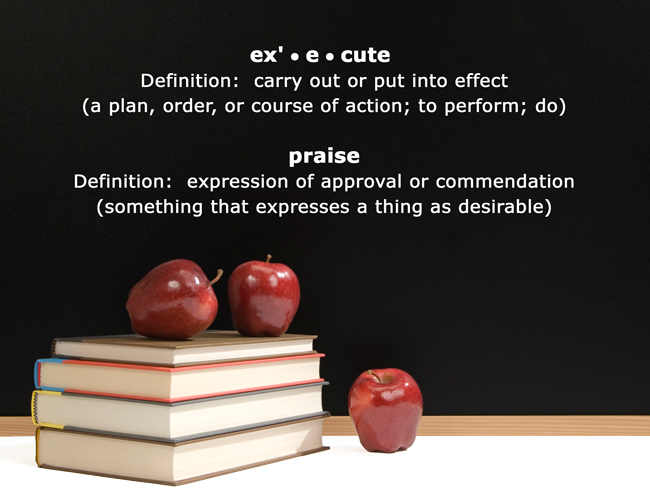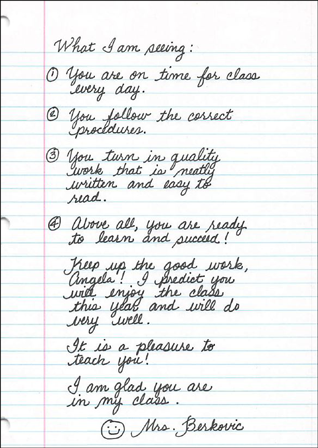
|
Effective Teaching...
by Harry and Rosemary Wong |
To print: Select File and then Print from your browser's menu ------------------------------------------------------------------ This article was printed from Teachers.Net Gazette, located at https://teachers.net. ------------------------------------------------------------------ |
Execute and Praise

What You Want Students to Do
“But I tell them over and over again what to do, and they just don’t do it!” This is the common lament we hear repeatedly from teachers. We contend that in most every instance it is not the child being mean, ornery, stubborn, or disrespectful when they don’t know what to do. It is the lack of what all effective teachers know what to do—practice, practice, practice—until the do becomes a done and a routine is established in the classroom.
Telling students what to do is just one of the three steps to teaching a procedure or what you want done in the classroom.
The Three Steps to Teaching a Procedure
Most behavior problems in the classroom are caused by the teacher’s failure to teach students how to follow procedures—how to execute the course of action. Telling is not teaching. Students must be physically engaged in the process if you want them to learn it.
To review the process of “How to Teach a Procedure,” please go to this past column, “The Problem Is Not Discipline” or read The First Days of School, page 175.
People get things done when they execute. They follow through. In a football game, everyone is focused on the goal line. Coaches shout at their players, “Execute, execute!” This means to run the play, follow through, and finish strong. In a game, that play may be called only once, but that one time could be the game-winning play or a formation to prevent an opponent’s score. Either way, the play must be executed correctly.
When students know what to do and how to do it—and they do it—you have created the optimum learning environment in your classroom. Teaching a student how to execute a procedure and follow-through create the routines of successful classrooms.
Meaningless Praise
Praise in the classroom is often hollow. Praise becomes meaningless quickly because no one is sure to whom the message is directed. Good teachers know not to issue generalized, complimentary praises that carry no specific personal meaning, such as “nice work,” “great kid,” or “good job.”
Teachers typically say, “Good job,” to offer approval. But what action caused this response from you? Was it because the student was in her seat on time or was it that the student had the right book on top of his desk? When students hear generalized praise, they have no idea who the teacher is referring to or what prompted such a response. These words go right over students’ heads as meaningless mantras.
Instead of generalized praise, reinforce what students do correctly. For instance, if a student does a procedure correctly, reinforce the deed so that they can personally see that you are referring to an act done by a specific student. This will help students take responsibility and ownership for the tasks that need to be done consistently, resulting in increased academic learning time and fewer behavioral problems.
Reinforce and Affirm a Correct Procedure
Do not praise the student; rather, reinforce and affirm the action.
Step 3 to teaching a procedure, “Reinforce,” is a critical step to turning procedures into routines.
Watch a sports coach, because good coaches are the best teachers. As the coach guides a team, class, or student through practice, corrections are called out and made instantly. The coach tells, shows, demonstrates, cajoles, and even loudly calls out commands until the task is done right.
But good coaches don’t stop there. They affirm and reinforce the correct technique by having the student do the acquired technique over and over again, each time exhorting the student to do it better, accompanied with words of accomplishment, high-fives, pats, and smiles of affirmation and encouragement.
Instead of praising a student,
praise the deed and encourage the student to repeat the action.
Encourage a student who follows a procedure by affirming the specific action or deed.
Tell the student exactly what was done well. Say, “Marvin, I see you know where to put your backpack when you come to class,” rather than, “Marvin, good job.”
For more information on this technique, read what Barbara Coloroso says in “Praise the Deed, Encourage the Student” in The First Days of School, page 184.
Praise and Polish
Effective teachers know how to Praise and Polish. That is, they praise to reinforce the deed and encourage the student to polish the work.
Instead of issuing generalized, complimentary praises that carry no specific personal meaning, there is a much more effective way to “praise” a student—Affirm the deed.
When you affirm a deed, the student knows exactly what the student did. You are affirming an accomplishment or encouraging appropriate procedural practice to be done again.
“Angela, you spelled all the words correctly. I know you can do it again.”
End with a smile, make eye contact with the student, and wait for confirmation.
When you receive the student’s confirmation, say, “Thank you!” and pat the student on the back or give her a high-five.
“Thank you for walking behind each other and for not disturbing the other classrooms.”
“Class, my compliments for passing the papers across the rows using the proper procedure.”
Specific Praise
Praising exactly what the person did, rather than the person, and then encouraging the person to do the accomplishment or deed again is called Specific Praise.
Students who receive specific praise believe, “You were paying attention to me. You noticed me! And you thanked me for doing something I did personally.”
Generalized praise is nice, but it is not tangible or meaningful.
“Justin, you are a bright child.”
For a more effective kind of praise, point to something the student did well. Affirm and encourage the student to do it again—for instance:
“Justin. Thank you for running the spam software. Look at how fast the screen changes now.”
“Pat yourself on the back and congratulate yourself. Please do it again the next time your computer slows down.”
These are some other examples:
“Thank you, Class. That was the correct procedure when you see my hand or hear a bell. Please do the same thing each time you see my hand or hear a bell.”
“Heidi, thank you for the excellent report at the faculty meeting. The next time I need assistance, I would truly appreciate your help again.”
“Julio, thanks for helping with the dishes tonight. Mom had to work late tonight and you helped out. The next time Mom needs assistance, I would be glad to have you help out again.”
Pep talks are invigorating but hollow. They become meaningless quickly because no one is sure to whom the message is directed. When you affirm the deed and encourage the student, you help the student do two things:
The key words are responsibility and accomplishment, two factors that help all people become successful in life.
Thank You for Noticing What I Do
Shoshana Berkovic at New Utrecht High School in New York City writes notes of affirmation and reinforcement to her students.
 Notice how she affirms specifically what the student did and encourages her to continue her good work.
Notice how she affirms specifically what the student did and encourages her to continue her good work.
It’s worth noting that the student was a borderline student the first two weeks of school and began to flourish after this note was presented.

What About Rewards?
Research shows that rewards do not necessarily increase a desired behavior, and that in some situations, rewards can, in fact, have negative effects. Rewards can be considered a way of controlling a student’s behavior and when students quickly figure out that they are being controlled or extrinsically manipulated, it will decrease their sense of satisfaction in completing or even working on a task.
Carrots are no more effective than sticks in helping students make responsible choices and are totally ineffective in cultivating a sense of fulfillment. A reward used to reinforce behavior is operant conditioning, the work of B. F. Skinner who is known for his work on conditioning mice to negotiate a maze to get a reward.
 You see this in classrooms where the “only reason students come to school” is to get something each day from the “Treasure Box.”
You see this in classrooms where the “only reason students come to school” is to get something each day from the “Treasure Box.”
Marvin Marshall, author of “Discipline without Stress,” shares this story about the expectation of a reward.
The elementary school hired a substitute during the absence of the regular teacher.
Upon returning from lunch, a student asked if the class had earned a star to put on the bulletin board for the quiet way in which the class had returned.
The substitute didn’t understand the request and asked about the procedure.
Another student explained that when students enter the classroom quietly, the teacher puts a star on the bulletin board. When a certain number of stars are reached, the class is given an afternoon without any work.
The substitute asked, “But aren’t you supposed to walk quietly in the hall so that you don’t disturb the other classes? Why should you earn a star for doing what is right?”
Students looked at each other, puzzled. Finally, one student explained, “We always get a reward. Why else should we do it?”
Instead of rewards, use specific praise. Rewards result in momentary extrinsic motivation, whereas specific praise results in intrinsic motivation and drives students to be responsible, conscientious, and deliberate in their actions.
Specific praise creates a culture of consistency in the classroom. It reinforces the “what to do” in a classroom so students will do it.
Execute for Learning
Execution of procedures from a Classroom Management Plan will lay the foundation of a successful classroom environment for learning to take place. When plans are in place, instructional time is optimized.
Carol Dwerk, Stanford University, has found that educators cannot hand students confidence on a silver platter by praising their intelligence (e.g., Aaron, you are so smart.). Instead, with specific praise the students see what they are doing well personally, and this will help them gain the tools they need to maintain their confidence in learning by keeping them focused on the process of achievement.
The routines of the classroom free students from the worry of “What do I need to do in this classroom to keep out of trouble?” and channel all of their energy into attending and learning. Learning does not take place in an atmosphere of chaos. Learning takes place in a classroom that plans for learning.
Our forthcoming book, THE Classroom Management Book, will take you by the hand to create a consistent, organized environment where students are poised to learn. With 50 procedures taught step-by-step and stories of implementation, you will learn how to create and execute a plan for your effectiveness. Click here to learn more about the book that will give you time to teach.
Thomas Edison is quoted as saying, “Visualization without execution is hallucination.” Close your eyes and look around the classroom and see students who are responsible and are ready to learn. See yourself teaching. See the students move from lesson to lesson, class to class. Watch them execute the procedures without a word from you. Hear yourself delivering affirmations throughout the day for doing things right. See every child learn and achieve.
Pat yourself on the back and tell yourself, “I did it. All of my procedures have created success for my students. I love teaching and my students love learning. I am a very effective teacher.”